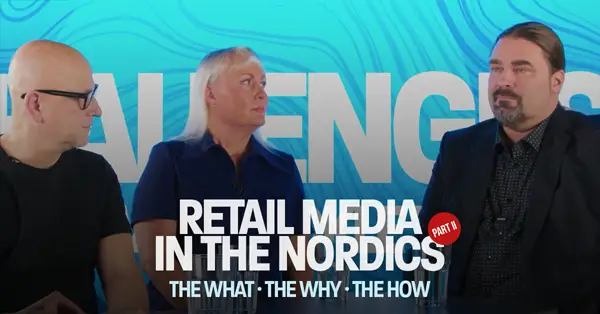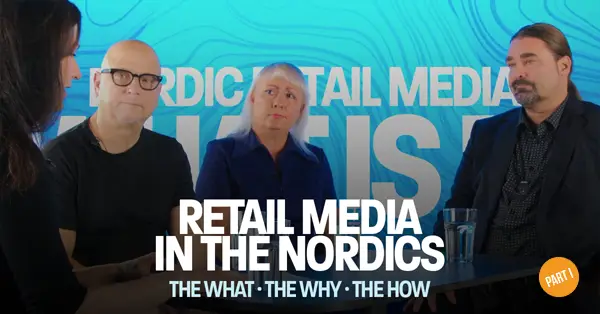What constitutes retail media?
What then makes actual retail media? Typically, when asked, I tell anyone ready to listen that it is a business model, in which retailers monetize their valuable audiences for advertisers. I do acknowledge that this is a simplified explanation, but when retail media is stripped from all of the business jargon, a few key elements do remain: The advertisers who need to reach consumers, the customer insight retailers have about the consumers that helps to reach them at the right moment as well as the context that attracts certain types of consumers in one place where they are more easily reached.

In a traditional multi-brand retailer environment, the natural advertisers are of course the owners of the brands sold in stores who want to get their products noticed. In retail media vocabulary, these advertisers are called endemic advertisers. The products advertised have a natural connection to the environment they are presented in. A simplified example of this is running shoes advertised in a sports store.
Another form of retail media is built around non-endemic advertisers. Non-endemic advertising means that the advertised product is not on sale in the context. Let’s say that an insurance company wants to reach pet owners. What would be a better place to reach this target group than a pet shop or a pet care department in a hypermarket? Especially when you have the retailer data to help you target the right buyers.
Most retailers start their retail media journey with endemic advertisers only. This is understandable, for example in grocery retail, you have thousands of brands wanting to have their share of customers’ attention. But as the business matures (and with smaller retailers with fewer brands in sale), non-endemic advertising starts to attract a lot of deserved attention.
Non-endemic advertising is also one of the key reasons why retail media is now already expanding at a pace outside the boundaries of its most typical environments.
Many faces of the new retail media
During the last 12 months, we’ve seen a new retail media network born every week as well as a major shift in retailers’ understanding that physical stores represent a huge opportunity to provide advertisers access to massive audiences just where the purchasing decisions are made.
Another exciting development has been the new areas of retail media has entered. Here are some of the most interesting ones.

Planet Fitness, a US-based gym chain with over 2500 clubs, hired its own media sales team and started utilizing its vast insight of health enthusiasts in offering interesting advertising opportunities to for example health & sports brands. They combine their in-gym screen network and omnichannel marketing capabilities to reach their 18,7 million members.

JP Morgan Chase announced Chase Media Solutions, their own retail media network covering over with 80 million customers. Banks in general of course have tons of 1st party data to create brilliant audiences for advertisers. JP Morgan Chase starts their retail media operations online but inevitably will be seen in a physical context as well.

T-Mobile announced its own retail media network covering 20 000 screens in more than 11,000 T-Mobile and Metro by T-Mobile retail locations. It will also partner with streaming media company Plex to extend the full-funnel reach.
Numerous other audience-heavy areas of business (such as gas stations) have also already entered the arena. This trend will surely only continue to strengthen in the coming years.
Where do we go from here?
As smaller retailers and other business areas will be joining the parade in fast-growing numbers, the models for selling the media to advertisers will get more diversified.
In major markets, such as the US, the biggest players in each business will be able to build their own retail media networks and organize operations. This requires lots of new resources, investments, and patience, to get things running smoothly.
Most chains wanting to get on board are not able to do this all by themselves. We see that midsize and smaller retailers and other industries will need help in building and running the network and selling the media. Thus, there is a space for a new kind of retail media network, operated by a media company and its partners, that takes care of the audience creation, campaign management, reporting and all the tasks needed for the retail media business to grow successfully.

The network members can themselves decide which part of the inventory they’ll be willing to open for sale in the network and which to keep themselves. The network can offer advertisers’ audiences both exclusively in one chain and also across the chains, that share similar audiences an advertiser wants to reach. We feel that there is also a strong possibility that these types of networks converge with data-rich digital out-of-home networks in the future.

Here in the Nordics, we and our sister company digital signage integrator Craneworks have partnered with Aller Media Finland, a part of Aller Media Nordic to provide midsize and smaller chains an easy way to get into retail media. Together we can offer advertisers unprecedented omni-channel access to interesting audiences in different areas of retail and chains in other audience-heavy sectors.







